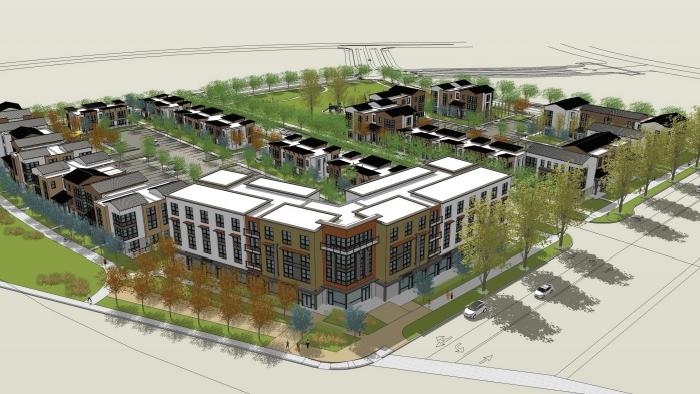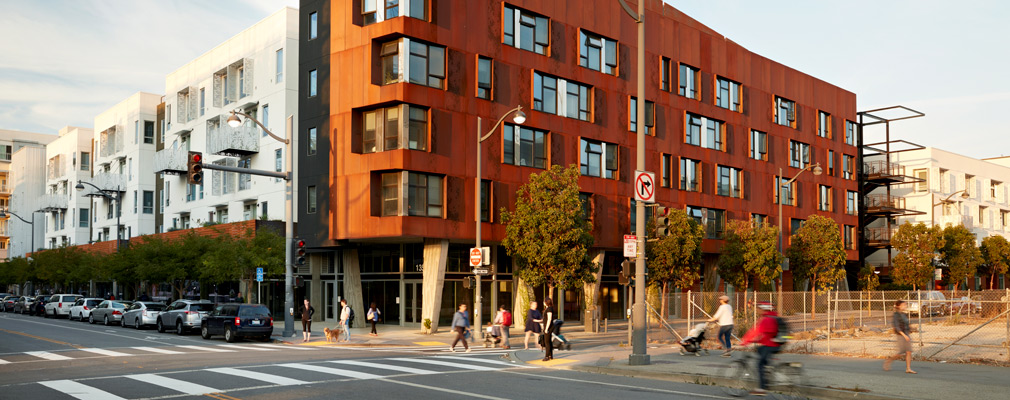
Ohlone Gardens, low-income housing in El Cerrito, Contra Costa County.
California’s Progressive War on Suburbia
When it’s unprofitable to build affordable homes, only taxpayer subsidized homes are affordable
By Edward Ring, February 18, 2020 2:20 am
The arrogance of environmentalists who believe suburbs to be a planetary abomination must be called out for what it is – extremism completely unjustified by reality.
For three years in a row, California’s progressive lawmakers have attempted to legislate higher density housing by taking away the ability of cities and counties to enforce local zoning laws. And for the third year in a row, the proposed law, Senate Bill 50 by Sen. Scott Wiener (D-San Francisco), was narrowly defeated. But eventually, inevitably, something like SB 50 is going to passed into law.

In opposition were homeowners who understandably don’t want their single family home neighborhoods subjected to random demolitions in order to replace single family homes with construction subsidized fourplexes to be filled with rent subsidized tenants. These homeowners, and the local elected officials who represent them, were joined by “housing justice advocates” who claimed the law didn’t adequately address the gentrification effect, whereby higher density developments often displace existing residents to construct luxury condominiums that only the wealthy can afford.
There’s a lot going on here, and it seems that very little in the way of analysis can support a dogmatic ideological perspective. For example, from a property rights perspective, you can argue that people who purchase homes have a right to expect the zoning density of the neighborhood to be respected, since that’s what they relied on when they invested their life savings and lifetime earnings. But a property rights perspective might also have one argue that each individual home owner has the right to do whatever they wish with their property, even if that means demolishing the home to construct a multi-story apartment building. These unresolved and conflicting interpretations of property rights prevent consensus and delay action.
And if some ideological dogmas lend themselves to contradictory interpretations, others simply defy reality entirely. Some of the housing justice advocates believe that providing shelter is a human right. For them, mandating taxpayer subsidized “affordable housing” construction, and taxpayer subsidized rent, is the only solution to California’s housing shortage and affordability crisis, and the sooner we get busy, the better. This unrealistic extension of human rights attracts opposition, if not ridicule, and in any case is impossibly expensive.
But perhaps the worst of the ideological dogmas that prevents rapid solutions to the housing challenges facing Californians is environmentalist values taken to extremes. The practical impact of regulations attendant to environmentalist values – from CEQA reporting requirements and CEQA lawsuits to burdensome and expensive building codes – is to make housing construction unprofitable for anything that might be considered affordable to the average Californian.
Environmentalist ideology hasn’t just made construction costs unaffordable, it has made land costs unaffordable as well, by passage of environmentalist inspired laws that strictly limit the amount of raw land that can get approved for new home construction. Around every city in California, with varying degrees of enforcement, “urban containment” boundaries have been established. Sometimes these boundaries serve important goals; to protect prime farmland, or to preserve important ecosystems such as wetlands for migratory birds. But it seems that almost all open land, everywhere within California’s vastness, is off limits to developers because of environmentalists.
California’s Regulations Destroyed Affordability
The problem with SB 50, or any eventual legislation that mandates higher housing density, is that without reforms to the laws that have made construction of affordable housing unprofitable, the only housing that will ever get built will be high-end homes by private investors, or housing that will require government subsidies both to construct and for the renters to be able to afford to live in them. This is not sustainable. It costs too much, and it takes too long. And it sets up a dangerous bifurcated society, where forcibly integrated into residential single family neighborhoods, randomly situated pretty much anywhere, are apartment buildings populated by residents receiving taxpayer funded rent subsidies.
There’s no doubt that some legislation may have to occur to selectively increase housing density. When a bill like SB 50 returns, which could be any day, certain modifications could help. In particular, SB 50 specified where state law could preempt local zoning, and included in “job-rich, good schools areas.” This is “inclusionary zoning” at its ostensibly high-minded, vindictive worst. The bill’s authors made this provision without any reference to whether or not “job-rich, good schools areas” are in parts of town that ought to naturally convert to higher density. Instead, the message seems to be “you’ve managed to maintain a prosperous and stable community with good schools and jobs, so into that community, we’re going to subsidize the entrance of predatory investors, who will purchase and demolish homes that come onto the market, replace them with apartments, and fill those apartments with people who never had to face down the astronomical mortgages that all you residents shouldered in order to have the right to live here.”
This is wrong. It destroys the incentive for anyone to ever want to pay extra to live in a decent neighborhood. Equally important, it destroys the incentive for low income individuals to work hard and aspire to move to a better neighborhood.
And to be clear: this provision would never impact truly wealthy neighborhoods. Those people can afford attorneys to tie development proposals up in knots for years, SB 50 or not. This provision attacks California’s middle class. As usual. Delete it.
On the other hand, within the urban core and on properties with frontage along major boulevards, it is an unfortunate reality for anyone still living there in single family homes that their property is doomed to transition. In the past, that would be accomplished because the value of a few of these properties, consolidated and rezoned for a large multi-family building, would make it a lucrative deal for the sellers. Now, however, the business model is broken. Not only has the impact of CEQA and overdone building codes raised costs, but the resultant entrance of public financing into the equation has made project labor agreements elevate the total project cost still further. The relatively recent entrance of powerful “nonprofit” corporations into the subsidized housing market has padded total project budgets and increased costs even more.
For these reasons, mandating densification, however better tuned the rules eventually turn out, is not enough. The entire economic landscape requires revision.
Rewriting SB 50 to Recognize Economic Reality
It is possible to increase the supply of housing without involving the government and taxpayers in the actual construction funding. It is possible as well to increase the supply of housing in a manner that allows the developers and landlords to earn a decent return on investment without involving the government and taxpayers in funding rent subsidies. Therefore, the next version of SB 50 might recognize and account for the following factors:
- Abandon “inclusive zoning” aimed at integrating subsidized low income residents into middle class neighborhoods via massive taxpayer expenditures.
- Restrict mandated higher density zoning to the core urban areas in California and along major traffic arteries. One absolute set of governing criteria should apply everywhere.
- Treat every county and city exactly the same, instead of allowing select counties and cities to take longer to come up with their own plans.
- Repeal or significantly reform the California Environmental Quality Act.
- Repeal energy neutral mandates and assorted other unwarranted environmentalist inspired building code regulations that add costs to home construction.
- Set a maximum period of time within which building permits can be granted, and set a maximum building fee at $10,000 per home/unit (or less).
- Streamline the building permit process to make it easier, not harder, for developers to acquire permits. Look to Texas for guidance.
- Ban project labor agreements and require open bidding processes for public works projects.
- Restore public funding to streets and connector roads instead of charging developer fees which are then reflected in much higher home prices.
- Repeal laws designed to prevent reasonable expansion of the urban footprint. Allow housing developments again on open land.
These and other changes would make it possible again for private homebuilders to profitably construct affordable housing. Redirecting public money into constructing enabling infrastructure would take additional financial pressure off of home builders as well as home buyers. That worked in the 1960s and 1970s in California, and it still works in other states. The overall cost of increased public investment in infrastructure is less, perhaps far less, than the cost of taxpayers subsidizing the construction, and then subsidizing the rent in perpetuity, for literally millions of units of housing.
There is a war on suburbia being waged in California. This ideological battle, where suburbanites are stigmatized as classist, privileged, and environmentally destructive, is utterly unfounded. Suburbs are where a majority of Americans prefer to raise their families. And not these new suburbs with a dozen “single family dwellings” per acre. Spacious, beautiful suburbs where homes sit on lots of at least 6,000 square feet; suburbs where the homes themselves might actually be smaller and more affordable, once the economic hindrances to building them are removed via legislative reforms.
The arrogance of environmentalists who believe suburbs to be a planetary abomination must be called out for what it is – extremism completely unjustified by reality. Everything, from cars to energy to building materials, are becoming clean and sustainable. And there’s plenty of open land in California to spare a few thousand more square miles for new human settlement. At the least, if environmentalists are serious about saving California’s ecosystems, they might stop making common cause with the open borders lobby, and they might endorse nuclear power. Until then, they are transparently hypocritical.
- Ringside: The Potential of Waste-to-Energy in California - April 17, 2024
- Ringside: How Much Water Will $30 Billion Buy? - April 10, 2024
- Ringside: Sacramento’s War on Water and Energy - April 4, 2024





“As a man is said to have a right to his property, he may be equally said to have a property in his rights. Where an excess of power prevails, property of no sort is duly respected. No man is safe in his opinions, his person, his faculties, or his possessions.”
– James Madison, National Gazette essay, March 27, 1792
Edward Ring, you are the BEST. Thank you again for keeping this stuff in the spotlight to inform us and for writing about it so clearly. We need to know what is really going on here under the euphemisms the state and local politicians (and others) use to hide what they are doing, which is not “smart,” is anything but “affordable,” and is not “inclusionary,” but is destructive for us and enriching for them.